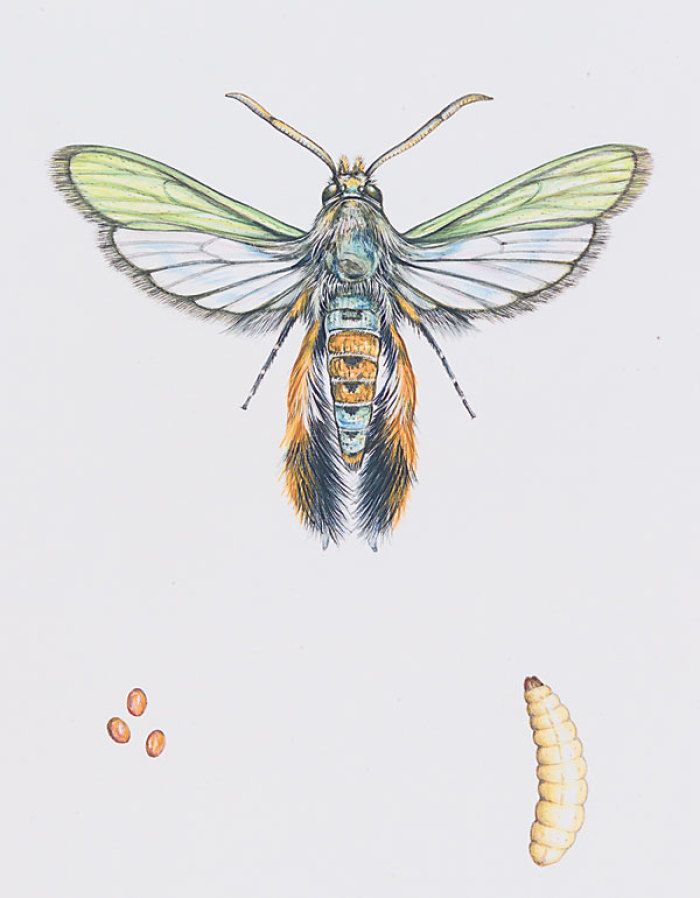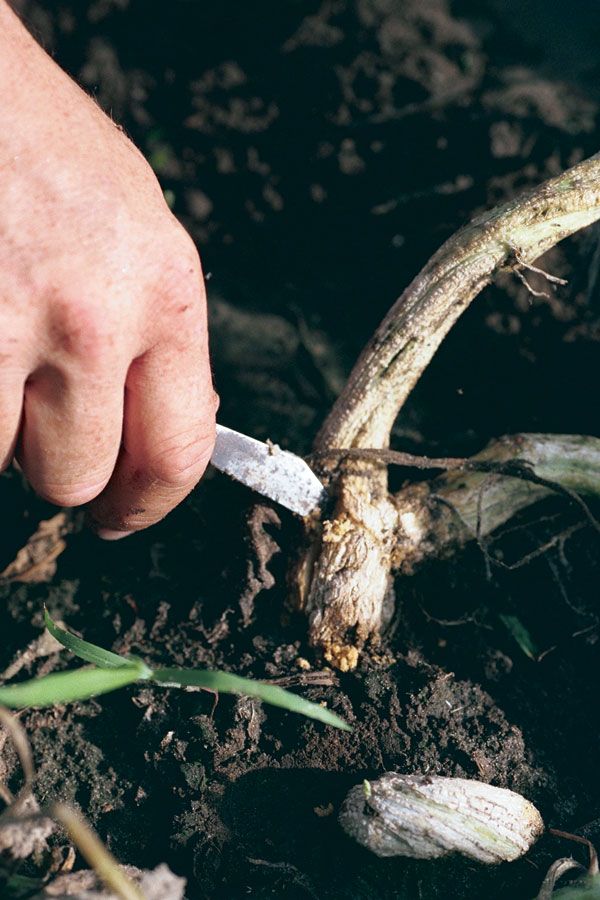Effective Ways to Control Squash Borers in the Vegetable Garden
If your squash plants are wilting, it may be because of this pernicious pest

Say you’re new to gardening and you’re growing squash for the first time. One day you notice the plants are suddenly wilting. If watering doesn’t help, you might ask neighbors or friends for advice. But what if you are without nearby friends who can take a look, or those who do can’t explain what they see? Here are some basic steps to take in figuring out what’s wrong, then deciding on a logical pest-control strategy. While our discussion here applies to squash vine borers, a similar approach can be taken with other pest problems.
Work from the symptoms
Often the sight of the pest itself alerts you to a potential problem. But just as frequently, it is a symptom you notice first, like the squash plants suddenly wilting or collapsing. Watering doesn’t help, so you wonder what to do next and whether the problem will spread to other squashes.
Then you closely examine the main stem of the plant, or the portion of the vine that has died back, and see one or more holes with a greenish, moist, sawdust-like material on the ground and within the hole. Guessing that something has entered the stem, you slit open the stem near the hole. Aha! Inside you find a brown-headed, fat, white larva, about ¾ inch long. There is more of the wet sawdust material, which by now you realize is the excrement, or frass, from the insect.
Find out the bug’s name
You have a key to all the world’s literature about this insect once you know its name. A common name is good, but the Latin name is better because there will be no confusion about which insect you are dealing with.
A gardening friend or neighbor might be able to tell you it’s a squash vine borer. Or call your local cooperative extension office, describe the damage and the larva, and no doubt you’ll learn both the common and the scientific name.
Then look up the pest by name or by the damage symptoms on the plant in a good garden book, learn something about the insect’s life cycle, and get suggestions for some nontoxic controls. These books also usually link pests with the plants they damage. Therefore, all you have to do is search under squash, find a description of the damage you see on your plants, and learn which pest is the culprit.
Learn the pest’s life cycle
Learning about an insect’s biology and life cycle is the key to finding least-toxic solutions for controlling it. In Destructive and Useful Insects, the authors explain that squash vine borers attack many varieties of squash, pumpkin, and other members of the cucurbit family in parts of the United States east of the Rockies from Canada to South America. They winter in the soil, an inch or two below the surface, in tough black cocoons, then emerge as moths in the spring about the time the squash plants send out runner vines. These large, swift, daytime-flying, orange and black, clear-winged moths are named Melittia cucurbitae. They lay small, flattened, brownish eggs on squash stems and leaf stalks, especially toward the base of plants. The young larvae hatch and enter the stems a week or two later. These borers tunnel along, eating the inner tissues of the stem for about a month. Then they leave the plant and make cocoons in the soil. In the North, they stay in the soil until spring, but in warmer areas there may be a second generation later in the season.
Now, armed with life-cycle information, let’s see how we can build a least-toxic control program for squash vine borers.
Start with good garden culture
In general, any insect that overwinters in the soil can be suppressed by using a number of horticultural controls. The first is rotation. By growing squash in a different area of the garden every year, borers emerging from the soil where the squashes were last year will have a certain distance to go to find them again. Every inch they have to travel exposes them to deadly predators and parasitoids.
Next, good garden cleanup is critical. When plants die back, and at the end of the summer, rake up all debris. Place all squash debris in a clear plastic bag. Tie the top, set the bag in the sun for a week to kill remnant insects, then add the debris to your compost pile.
After raking, turn the top couple of inches of soil so cocoons are brought to the surface. Over the winter, they will be killed by cold temperatures, especially alternate freezing and thawing. They’ll also be exposed to birds, mice, shrews, and insect predators.
In spring, turn over the soil deeply, so any surviving cocoons are left at a greater depth than the usual inch or two. Deeply buried, the emerging insects will have a tough time making it to the surface.
Plant smart and safeguard seedlings
If you live in a warm region, where two generations of squash vine borers are a threat, it’s worthwhile to stagger your squash plantings over time, assuming some of the plants will have a chance to grow large before the moths lay eggs again. The larger the plants, the greater the chance some vines will survive to produce fruit when borers attack. Along the same lines, pinch back young plants to encourage branching. With more stems, some will be spared attack by borers, and more will survive borer removal.
Adult moths are swift fliers, so they’re tough to catch even if you do spot them in the garden. But you can protect young plants with physical barriers like row covers or agricultural fleece, making sure they are well secured and free from holes.
The problem with row covers, however, is pollination. Squash blossoms are pollinated by insects, usually bees. So uncover squash plants when the female flowers open, and let the bees do their work. Of course, the minute you uncover the plants they are vulnerable to pests. But by the time the female flowers have started to open, your squash plants should be large enough to withstand some borer damage.
Protect plant stems from borers
When you uncover the plants for pollination, provide some protective barrier for their main stems. Moths like to lay eggs toward the base of squash plants, and damage to the main stems is most likely to cause fatal injury. Wind nylon stockings or strips of aluminum foil around the stems. A large paper cup, with sides split and bottom removed, can be fit upside down around the stem. In all cases, the barriers should start just below soil level and rise at least 6 inches up the stem.
Show no mercy when you catch them
An obvious control is to kill the pests by hand. When you see eggs glued to a stem, scrape them off with a dull knife or crush them. If you see a suspicious hole littered with frass, slit open the stem directly above it and carefully remove the borer with a knife or wire. Take care to injure the walls of the vine as little as possible. Then immediately cover the cut area of the stem with soil, and the vine will probably survive.
Since many squashes can put out new roots from nodes along the stem, bury a few long trailing runners. That way, if there is dieback due to borer damage on some stems, you will have new plant sections already rooted.
Biological pesticides are an option
Insect-eating nematodes can be used to kill squash vine borers. A solution of the nematodes is injected into plant stems with a syringe when the holes of the borers are first seen. There are three species of insect-eating nematodes available commercially. Ask suppliers to recommend which species will be effective on squash vine borers and how much you’ll need to get the job done.
Last but not least, you may wish to inject squash stems with Bacillus thuringiensis kurstaki, or Btk, the bacteria that kill many caterpillars. Follow directions for mixing up the material right before use, just as you would for a spray.
Start by injecting Btk into the main stems within an inch or so of the soil, about the time blossoms start to open. Repeat the injections in 10 to 14 days. Your goal is to bathe the inside of the hollow stems with the Btk solution. Any borers present will eventually die after eating stem material coated with Btk.
Good bug reference books
Destructive and Useful Insects by C. L. Metcalf and W. P. Flint. McGraw-Hill, 1992.
The classic text for students of entomology. We turn to it first when starting a search.
Chemical-Free Yard and Garden by A. Carr et al. Rodale Press, 1991.
A sophisticated text written for the home gardener, with a great deal of excellent information on the use of beneficial insects.
Rodale’s Garden Problem Solver by J. Ball. Rodale Press, 1988.
Includes many innovative solutions to pest problems.
Gardener’s Guide to Common Sense Pest Control by William Olkowski, Sheila Daar, and Helga Olkowski. The Taunton Press, 1995.
Another good reference on least-toxic methods for solving pest problems.
This article originally appeared in Kitchen Gardener #16 (August 1998).
Fine Gardening Recommended Products

Razor-Back Potato/Refuse Hook
Fine Gardening receives a commission for items purchased through links on this site, including Amazon Associates and other affiliate advertising programs.

Pruning Simplified: A Step-by-Step Guide to 50 Popular Trees and Shrubs
Fine Gardening receives a commission for items purchased through links on this site, including Amazon Associates and other affiliate advertising programs.

Ho-Mi Digger - Korean Triangle Blade
Fine Gardening receives a commission for items purchased through links on this site, including Amazon Associates and other affiliate advertising programs.







Comments
Log in or create an account to post a comment.
Sign up Log in